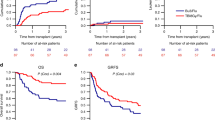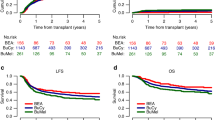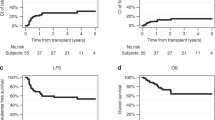Summary:
We previously demonstrated that Busulfan–Thiotepa (Bu–Thio) and ASCT effectively treated patients with locally relapsed medulloblastoma after surgery and conventional chemotherapy. We thus evaluated the administration of Bu–Thio in patients relapsing after conventional CNS irradiation. Patients were scheduled to receive Busulfan (600 mg/m2) and Thiotepa (900 mg/m2) and ASCT. Resection of residual tumour and additional irradiation were performed if necessary and feasible after Bu–Thio. Toxicity was compared to that observed in 35 patients treated without previous CNS irradiation. From 5/88 to 3/02, 15 patients were treated according to this strategy. Toxicity was significantly higher than that observed in unirradiated patients: thrombocytopenia <50 000/mm3 lasting 56 days (13–732) (P=0.02) and 30 days (4–124), respectively, HVOD (10/15 and 12/35 patients, respectively) (P=0.06), neurological toxicity (8/15 vs 3/35 patients) (P=0.01). Tumour response was assessable in seven patients and consisted in two CR, three PR and two NR. Currently, two of 15 patients are alive with no evidence of disease. In conclusion, the toxicity of Bu–Thio was significantly more severe in previously irradiated patients. In spite of a high response rate, this strategy failed to improve the prognosis of previously irradiated patients with a relapse from a medulloblastoma.
This is a preview of subscription content, access via your institution
Access options
Subscribe to this journal
Receive 12 print issues and online access
$259.00 per year
only $21.58 per issue
Buy this article
- Purchase on Springer Link
- Instant access to full article PDF
Prices may be subject to local taxes which are calculated during checkout
Similar content being viewed by others
References
Bloom HJ, Glees J, Bell J et al. The treatment and long-term prognosis of children with intracranial tumors: a study of 610 cases, 1950–1981. Int J Radiat Oncol Biol Phys 1990; 18: 723–745.
Taylor RE . United Kingdom Children's Cancer Study Group (UKCCSG) radiotherapy and brain tumour groups: medulloblastoma/PNET and craniospinal radiotherapy (CSRT): report of a workshop held in Leeds, 30 June 1999. Clin Oncol (Roy Coll Radiol) 2001; 13: 58–64.
Bailey CC, Gnekow A, Wellek S et al. Prospective randomised trial of chemotherapy given before radiotherapy in childhood medulloblastoma. International Society of Paediatric Oncology (SIOP) and the (German) Society of Paediatric Oncology (GPO): SIOP II. Med Pediatr Oncol 1995; 25: 166–178.
Albright AL, Wisoff JH, Zeltzer PM et al. Effects of medulloblastoma resections on outcome in children: a report from the Children's Cancer Group. Neurosurgery 1996; 38: 265–271.
Freeman CR, Taylor RE, Kortmann RD, Carrie C . Radiotherapy for medulloblastoma in children: a perspective on current international clinical research efforts. Med Pediatr Oncol 2002; 39: 99–108.
Thomas PR, Deutsch M, Kepner JL et al. Low-stage medulloblastoma: final analysis of trial comparing standard-dose with reduced-dose neuraxis irradiation. J Clin Oncol 2000; 18: 3004–3011.
Crafts DC, Levin VA, Edwards MS et al. Chemotherapy of recurrent medulloblastoma with combined procarbazine, CCNU, and vincristine. J Neurosurg 1978; 49: 589–592.
Crist WM, Ragab AH, Vietti TJ et al. Chemotherapy of childhood medulloblastoma. Am J Dis Child 1976; 130: 639–642.
Evans AE, Jenkin RD, Sposto R et al. The treatment of medulloblastoma. Results of a prospective randomized trial of radiation therapy with and without CCNU, vincristine, and prednisone. J Neurosurg 1990; 72: 572–582.
Tait DM, Thornton-Jones H, Bloom HJ et al. Adjuvant chemotherapy for medulloblastoma: the first multi-centre control trial of the International Society of Paediatric Oncology (SIOP I). Eur J Cancer 1990; 26: 464–469.
Baram TZ, van Eys J, Dowell RE et al. Survival and neurologic outcome of infants with medulloblastoma treated with surgery and MOPP chemotherapy. A preliminary report. Cancer 1987; 60: 173–177.
Packer RJ, Sutton LN, Elterman R et al. Outcome for children with medulloblastoma treated with radiation and cisplatin, CCNU, and vincristine chemotherapy. J Neurosurg 1994; 81: 690–698.
Duffner PK, Horowitz ME, Krischer JP et al. Postoperative chemotherapy and delayed radiation in children less than three years of age with malignant brain tumors. N Engl J Med 1993; 328: 1725–1731.
Geyer JR, Zeltzer PM, Boyett JM et al. Survival of infants with primitive neuroectodermal tumors or malignant ependymomas of the CNS treated with eight drugs in 1 day: a report from the Childrens Cancer Group. J Clin Oncol 1994; 12: 1607–1615.
Horowitz ME, Mulhern RK, Kun LE et al. Brain tumors in the very young child. Postoperative chemotherapy in combined-modality treatment. Cancer 1988; 61: 428–434.
White L, Johnston H, Jones R et al. Postoperative chemotherapy without radiation in young children with malignant non-astrocytic brain tumours. A report from the Australia and New Zealand Childhood Cancer Study Group (ANZCCSG). Cancer Chemother Pharmacol 1993; 32: 403–406.
Dupuis-Girod S, Hartmann O, Benhamou E et al. Will high dose chemotherapy followed by autologous bone marrow transplantation supplant cranio-spinal irradiation in young children treated for medulloblastoma? J Neurooncol 1996; 27: 87–98.
Kalifa C, Hartmann O, Demeocq F et al. High-dose busulfan and thiotepa with autologous bone marrow transplantation in childhood malignant brain tumors: a phase II study (see comments). Bone Marrow Transplant 1992; 9: 227–233.
Dunkel IJ, Finlay JL . High dose chemotherapy with autologous stem cell rescue for patients with medulloblastoma. J Neurooncol 1996; 29: 69–74.
Dunkel IJ . High-dose chemotherapy with autologous stem cell rescue for malignant brain tumors. Cancer Invest 2000; 18: 492–493.
Finlay JL, Goldman S, Wong MC et al. Pilot study of high-dose thiotepa and etoposide with autologous bone marrow rescue in children and young adults with recurrent CNS tumors. The Children's Cancer Group. J Clin Oncol 1996; 14: 2495–2503.
Dunkel IJ, Boyett JM, Yates A et al. High-dose carboplatin, thiotepa, and etoposide with autologous stem-cell rescue for patients with recurrent medulloblastoma. Children's Cancer Group. J Clin Oncol 1998; 16: 222–228.
Finlay JL . The role of high-dose chemotherapy and stem cell rescue in the treatment of malignant brain tumors. Bone Marrow Transplant 1996; 18 (Suppl. 3): S1–S5.
Graham ML, Herndon JE, Casey JR et al. High-dose chemotherapy with autologous stem-cell rescue in patients with recurrent and high-risk pediatric brain tumors. J Clin Oncol 1997; 15: 1814–1823.
Papadakis V, Dunkel IJ, Cramer LD et al. High-dose carmustine, thiotepa and etoposide followed by autologous bone marrow rescue for the treatment of high risk central nervous system tumors. Bone Marrow Transplant 2000; 26: 153–160.
Torres CF, Rebsamen S, Silber JH et al. Surveillance scanning of children with medulloblastoma. N Engl J Med 1994; 330: 892–895.
Zia MI, Forsyth P, Chaudhry A et al. Possible benefits of high-dose chemotherapy and autologous stem cell transplantation for adults with recurrent medulloblastoma. Bone Marrow Transplant 2002; 30: 565–569.
Marcus RE, Goldman JM . Convulsions due to high-dose busulphan. Lancet 1984; 2: 1463.
Meloni G, Nasta L, Pinto RM et al. Clonazepam prophylaxis and busulfan-related myoclonic epilepsy in autografted acute leukemia patients. Haematologica 1995; 80: 532–534.
Vassal G, Deroussent A, Hartmann O et al. Dose-dependent neurotoxicity of high-dose busulfan in children: a clinical and pharmacological study. Cancer Res 1990; 50: 6203–6207.
Avril M, Hartmann O, Valteau-Couanet D et al. Antiinfective prophylaxis with ceftazidime and teicoplanin in children undergoing high-dose chemotherapy and bone marrow transplantation. Pediatr Hematol Oncol 1994; 11: 63–73.
Bearman SI, Appelbaum FR, Buckner CD et al. Regimen-related toxicity in patients undergoing bone marrow transplantation. J Clin Oncol 1988; 6: 1562–1568.
Zeltzer PM, Friedman HS, Norris DG, Ragab AH . Criteria and definitions for response and relapse in children with brain tumors. Cancer 1985; 56: 1824–1826.
Taylor RE . United Kingdom Children's Cancer Study Group (UKCCSG) radiotherapy and brain tumour groups: medulloblastoma/PNET and craniospinal radiotherapy (CSRT): report of a workshop held in Leeds, 30 June 1999. Clin Oncol (Roy Coll Radiol) 2001; 13: 58–64.
Packer RJ, Goldwein J, Nicholson HS et al. Treatment of children with medulloblastomas with reduced-dose craniospinal radiation therapy and adjuvant chemotherapy: A Children's Cancer Group Study. J Clin Oncol 1999; 17: 2127–2136.
Packer RJ, Sutton LN, Elterman R et al. Outcome for children with medulloblastoma treated with radiation and cisplatin, CCNU, and vincristine chemotherapy. J Neurosurg 1994; 81: 690–698.
Belza MG, Donaldson SS, Steinberg GK et al. Medulloblastoma: freedom from relapse longer than 8 years – a therapeutic cure? J Neurosurg 1991; 75: 575–582.
Heideman RL, Packer RJ, Reaman GH et al. A phase II evaluation of thiotepa in pediatric central nervous system malignancies. Cancer 1993; 72: 271–275.
Boland I, Vassal G, Morizet J et al. Busulphan is active against neuroblastoma and medulloblastoma xenografts in athymic mice at clinically achievable plasma drug concentrations. Br J Cancer 1999; 79: 787–792.
Grill J, Kalifa C . High dose chemotherapy for childhood ependymona (letter; comment). J Neurooncol 1998; 40: 97.
Bouffet E, Raquin M, Doz F et al. Radiotherapy followed by high dose busulfan and thiotepa: a prospective assessment of high dose chemotherapy in children with diffuse pontine gliomas. Cancer 2000; 88: 685–692.
Casamassima F, Ruggiero C, Caramella D et al. Hematopoietic bone marrow recovery after radiation therapy: MRI evaluation. Blood 1989; 73: 1677–1681.
Hendry JH . The cellular basis of long-term marrow injury after irradiation. Radiother Oncol 1985; 3: 331–338.
Mauch P, Constine L, Greenberger J et al. Hematopoietic stem cell compartment: acute and late effects of radiation therapy and chemotherapy. Int J Radiat Oncol Biol Phys 1995; 31: 1319–1339.
Parmentier C, Morardet N, Tubiana M . Late effects on human bone marrow after extended field radiotherapy. Int J Radiat Oncol Biol Phys 1983; 9: 1303–1311.
Wolff SN, Herzig RH, Fay JW et al. High-dose N,N′,N″-triethylenethiophosphoramide (thiotepa) with autologous bone marrow transplantation: phase I studies. Semin Oncol 1990; 17: 2–6.
Ashley DM, Longee D, Tien R et al. Treatment of patients with pineoblastoma with high dose cyclophosphamide. Med Pediatr Oncol 1996; 26: 387–392.
Carli M, Colombatti R, Oberlin O et al. High-dose melphalan with autologous stem-cell rescue in metastatic rhabdomyosarcoma. J Clin Oncol 1999; 17: 2796–2803.
Finlay JL, August C, Packer R et al. High-dose multi-agent chemotherapy followed by bone marrow ‘rescue’ for malignant astrocytomas of childhood and adolescence. J Neurooncol 1990; 9: 239–248.
Hartmann O, Benhamou E, Beaujean F et al. High-dose busulfan and cyclophosphamide with autologous bone marrow transplantation support in advanced malignancies in children: a phase II study. J Clin Oncol 1986; 4: 1804–1810.
Cahill RA, Spitzer TR, Mazumder A . Marrow engraftment and clinical manifestations of capillary leak syndrome. Bone Marrow Transplant 1996; 18: 177–184.
Shulman HM, Gown AM, Nugent DJ . Hepatic veno-occlusive disease after bone marrow transplantation. Immunohistochemical identification of the material within occluded central venules. Am J Pathol 1987; 127: 549–558.
Chalandon Y, Roosnek E, Mermillod B et al. Prevention of veno-occlusive disease with defibrotide after allogeneic stem cell transplantation. Biol Blood Marrow Transplant 2004; 10: 347–354.
Versluys B, Bhattacharaya R, Steward C et al. Prophylaxis with defibrotide prevents veno-occlusive disease in stem cell transplantation after gemtuzumab ozogamicin exposure. Blood 2004; 103: 1968.
Corbacioglu S, Greil J, Peters C et al. Defibrotide in the treatment of children with veno-occlusive disease (VOD): a retrospective multicentre study demonstrates therapeutic efficacy upon early intervention. Bone Marrow Transplant 2004; 33: 189–195.
Acknowledgements
We thank Lorna Saint Ange for editing.
Author information
Authors and Affiliations
Corresponding author
Rights and permissions
About this article
Cite this article
Valteau-Couanet, D., Fillipini, B., Benhamou, E. et al. High-dose busulfan and thiotepa followed by autologous stem cell transplantation (ASCT) in previously irradiated medulloblastoma patients: high toxicity and lack of efficacy. Bone Marrow Transplant 36, 939–945 (2005). https://doi.org/10.1038/sj.bmt.1705162
Received:
Accepted:
Published:
Issue Date:
DOI: https://doi.org/10.1038/sj.bmt.1705162
Keywords
This article is cited by
-
Outcomes of a radiation sparing approach in medulloblastoma by subgroup in young children: an institutional review
Child's Nervous System (2023)
-
Medulloblastoma in the Modern Era: Review of Contemporary Trials, Molecular Advances, and Updates in Management
Neurotherapeutics (2022)
-
Medulloblastoma: an Old Diagnosis with New Promises
Current Oncology Reports (2020)
-
Treatment of recurrent primitive neuroectodermal tumors (PNET) in children and adolescents with high-dose chemotherapy (HDC) and stem cell support: results of the HITREZ 97 multicentre trial
Journal of Neuro-Oncology (2014)
-
Low-level copy number changes of MYC genes have a prognostic impact in medulloblastoma
Journal of Neuro-Oncology (2011)



